cbmail.bag4
Back to First Page.Bridger Casts Wide Net to Chase down cb's
Dear Joseph,
I have "chased" covered bridges in some 35 states and 7 countries. Since I am a member of 18
covered bridge societies/organizations, I have written articles for most of them.
My wife and I have met some very interesting
and strange people. We found it's never too old or smart to learn.
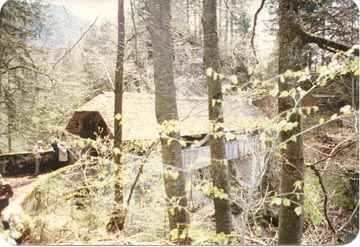 |
World Guide Number S-07-03 Fribourg Canton, Switzerland Photo by Conrad Nagengast |
[I] Have over 60 albums of covered bridge photos.
Sincerely,
Conrad (Connie)M. Nagengast
A Vermont style covered bridge discovered in
California!
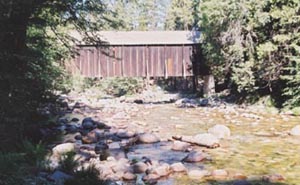 |
The Wawona Bridge (WG# 05-22-01), located in the Yosemite National Park, is the national park system's only covered bridge. The World Guide To Covered Bridges lists it as a 130-foot queenposter dated 1875 spanning the South Fork of the Merced River, serving as an entrance to the park. Photo by Robert C. Davidson. [130 feet is a tad long for a queenpost truss. Would a knowledgeable reader please enlarge on this description? Editor.] |
Eden, Vermont resident Lynn Davidson returned recently from a visit to California thrilled to
have found a Vermont-style covered bridge there.
The story of the covered bridge began with
Vermonter Henry Washburn who bought Mariposa County's Wawona Hotel in 1875. That same
year, interested in attracting people and business to the area, Washburn joined two Mariposa
businessmen to build the six-mile South Fork and Turnpike Road to the Mariposa Grove of Giant
Sequoias.
Also in 1875, Washburn put a roof and sides on
a wooden bridge, built originally in 1857 by pioneer Galen Clark, as a reminder of his Vermont
home.
Incidentally, in 1881, still interested in
attracting visitors, it was Vermonter Washburn who had a natural burn-scar cavity enlarged in one
of the Mariposa Grove's largest sequoias creating the drive-through Wawona Tunnel Tree. This
area became part of Yosemite National Park in 1932.
Stearns Bridge, Jeffersonville?
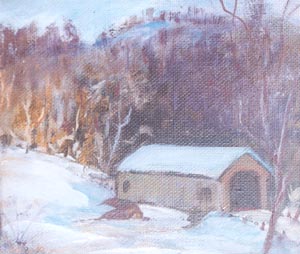
About The Fisher Covered Railroad Bridge
Mr. Nelson, I drove by the `Fisher' bridge in Wolcott, VT. I was surprised and pleased to see
major rehab or restoration work being done on the bridge. Can you enlighten me on this project?
Would this be in connection to the "Rails to Trails" project announced by the State of Vt. recently
concerning the old SO & LC RR right of way?
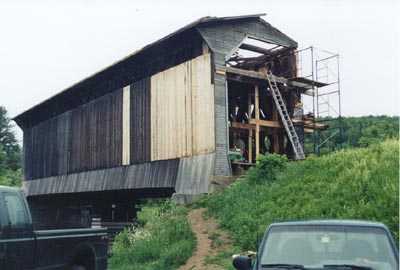 |
The photos of Jan Lewandoski's
crew working on the Fisher Covered Railroad Bridge on this page were taken by Roger Robar
June 29, 2001. © 2001 Roger Robar. |
I would appreciate your information and comments. Enclosed is a stamp for a reply or if you wish, use my e-mail address. Roger Robar
Mr. Robar: I checked with the Vermont Agency of Transportation and I was informed that the Agency has no ongoing projects concerning that bridge. Last year there was a handicap-accessible fishing platform put in on the river bank. Perhaps the Lamoille County Planning Commission has taken a hand. I will try a contact there. Sincerely, Joe Nelson
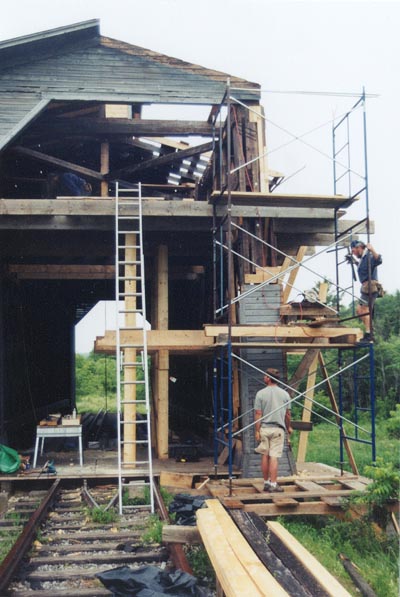
|
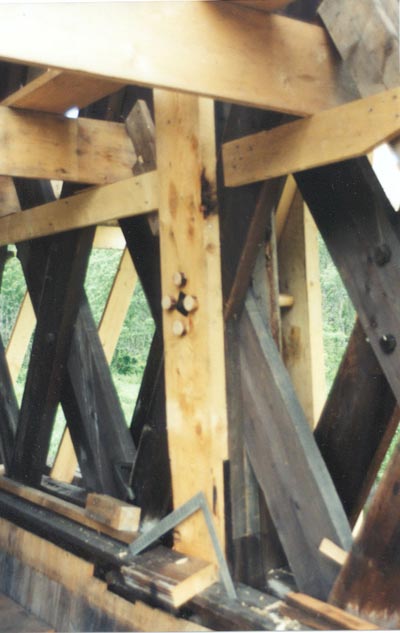
|
Thank you Joe for your reply. Again, last week I drove by the Fisher Bridge to Morrisville,
the restoration, rehab work was still going on. Steel staging is erected on the inside and some on
the outside of the bridge. It appears the roofing has been stripped with new roof boards applied in
some areas. Also it looks like some new heavy framing is in place at the top of the sides. I do not
know if this is temporary or permanent.
The next time I'm going that way I will
plan to allow time to photograph and ask questions. Roger Robar
Mr. Robar: I'm sorry we don't seem to know much. I received a reply from the Lamoille
County Planning Commission and he knows nothing about it, nor did VTrans.
If you take photos I would be pleased to
have copies for the record. Meanwhile, I am forwarding your latest email to the VTrans contact.
Maybe it will ring a bell.
Previous work on the Fisher Bridge was
done under contract by Jan Lewandoski, an excellent bridge wright and timber structures
contractor. I will also forward this to him, maybe he knows what the activity is.
Mystified, Joe Nelson
Dear Joe, That is indeed my crew
working on the Fisher Bridge, for the fourth time, structurally repairing the 4th corner and
replacing the rotten
portions of the roof and roofing. This remarkable bridge, built late in 1908, was easily able to
carry its 150 ton live load for 60 years until leakage of the low pitched rolled roofing covered roof
caused substantial deterioration of the top chords and some lattice. We also have changed bed
timbers and bottom chord members and entire 31 ft. lattice that rotted out near the abutments in
the past. This bridge is difficult to work on because it is so heavy, it no longer has a floor system
so it is unstable below, and the double lattice makes it hard to disassemble. Pins are commonly 21
to 29 inches long, and the truss is 42 inches through at the bottom, and 25 ft. tall.
Features to note in the bridge are the
double lattice, the unusual metal tension connectors in the bottom chord, and the large natural
knees at the portals. Jan
[Footnote: Our inquiry found that is was Vermont's Division for Historic Preservation that had let the contract for repairs to the bridge. The St. J.&L.C. R.R. agreed to deed the bridge over to the State in the event of the railroad's abandonment, but the entire line was deeded over to the State in 1973. While inactive, the LVRC has not been abandoned. In the lease between the State and the Lamoille Valley Railroad Corporation the Agency of Transportation would be responsible for maintaining the wooden superstructure, while LVRC would be responsible for maintaining the modern steel bridge that now supports the track structure. Our thanks to Roger Robar for the use of his photographs and for bringing about this interesting bit of research. J.N.]
Thetford Center Mystery Bridge
Mrs. C. of Providence RI asks if anyone can identify this covered bridge drawn by artist Arthur
Gibbes Burton.
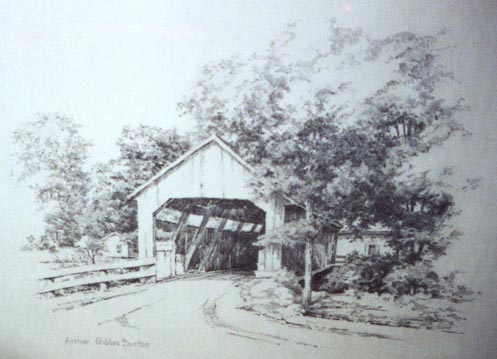
It was thought to be the Union Village Bridge, but unless the portal construction was changed over the years, it doesn't match -- the Union Village Bridge gable is extended while the mystery bridge gable is not.
The drawing shows the internal braces characteristic of a multiple kingpost truss. It is not Sayers Bridge with its Haupt truss because the signature arch is missing from the drawing. (the artist neglected to draw the vertical posts, maybe he skipped the arch too.) Also, the portal opening differs. The drawing does not match a photo of the long-gone Post Mills Bridge either.
The Thetford Historical Society records that five area covered bridges survived until the mid nineteen-hundreds and then three were lost to the Union Village Dam Flood Control Project.
If someone can identify the mystery bridge please contact CB Mail Bag through jcnelson@together.net
July 1, 2001 - Joe, The mystery Bridge in your "Covered Bridge Mailbag" is I believe the Cook Bridge (45-09-27G) which was removed for the flood control Dam in 1947. In the NSPCB Topics for January, 1957. There is a paragraph which reads as follows:
"The Cook Bridge which used to lead to the Town Clerks house in the section to be submerged, was taken out, and the Buzzell's Bridge just above was floated off its abutments and was destroyed by water held back by the dam."
If you look at a county map today, there was a road leading from just above Union Village and went almost directly north to Thetford Center. This would be from Highway 132 and 113A. Both of these bridges were on this road.
C. Ernest Walker Black & White post card No. 391 depicts the Cook Bridge. - Dick Roy, NSPCB Historian
June 26, 2001: Covered Bridge - Greene County TN. I would like to know if the Old
Wooden Covered Bridge located on Warrensburg Rd in Greene County, Tennessee has been
identified by the NSPCB. Last year this bridge was set afire by unknown persons. The bridge
sustained some small damage. I visited this bridge two weeks ago and it is in bad need of repair
and maintenance and other members of my extended family have a great deal of heritage
connected to this bridge because our name is above the entrance as Bible Bridge.
Darrell Bible
Dear Mr. Bible: The World Guide to Covered Bridges published by the NSPCB lists your bridge as crossing the Little Chucky as the Bible or Chucky Bridge. The 57-foot queen post truss bridge was built in 1922. The World Guide number is 42-30-01. It is one of six covered bridges surviving in Tennessee. Joe Nelson
If someone has knowledge of preservation plans for the Bible Bridge please contact CB Mail Bag through jcnelson@together.net
22 May 22, 2001: Trivia Question - First of all, I would like to say that I just visited your page & found it quite interesting.
Secondly, I read the trivia section specifically the "Why are covered bridges covered" and while that explanation makes perfect sense, is that the only reason? Someone told me that it was also because the horses would get spooked going across conventional bridges so they enclosed them. I was wondering if there was any truth to it or if that was a myth. If you could shed some light on this, I would appreciate it. -Brian Barcomb-
Dear Mr. Barcomb: There are many stories about why covered bridges are covered, all of them interesting. Horses had been crossing bridges for centuries before bridges were covered. Now, a little history:
Timothy Palmer of Rowley Massachusetts ( 1751 - 1821), famed Yankee bridge builder, constructed the "Permanent Bridge" over the Schuylkill River in 1806. When the bridge was completed, the president of the bridge company suggested that it be roofed to better preserve the timbers. Palmer went further, covering the sides as well. Thus, America's first covered bridge came to be. Builders of the time felt that this extra step would extend the useful life of a timber bridge up to 40 years. Joe Nelson
 Joe Nelson, P.O Box 267, Jericho, VT 05465-0267
Joe Nelson, P.O Box 267, Jericho, VT 05465-0267
This file posted June 28, 2001, revised December 3, 2003